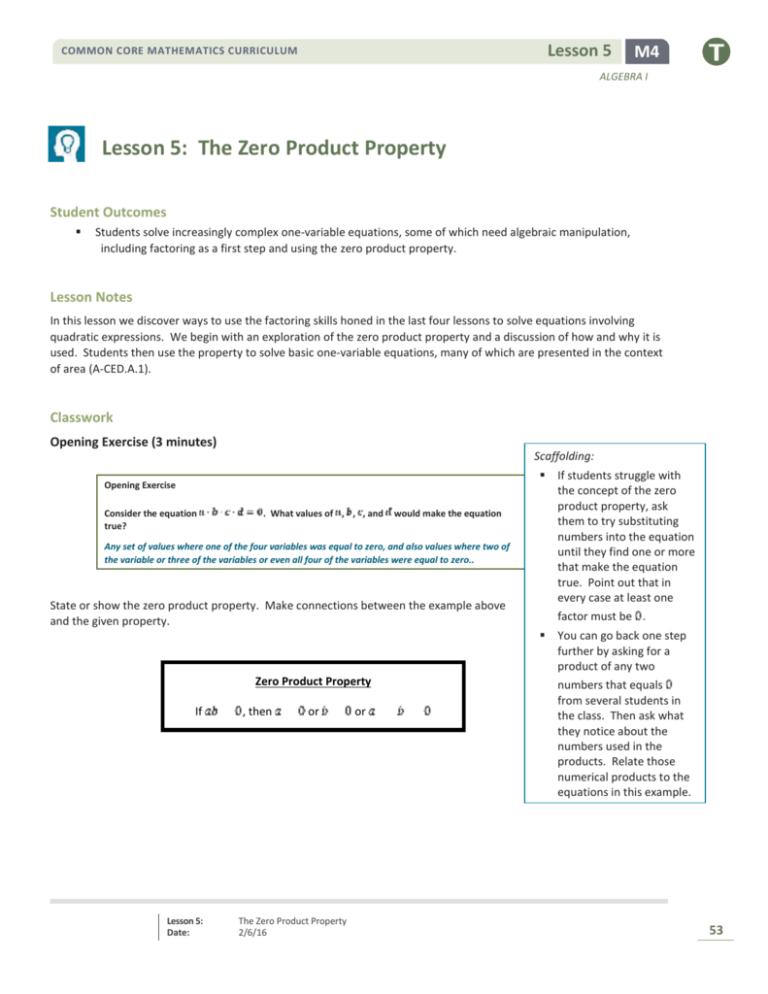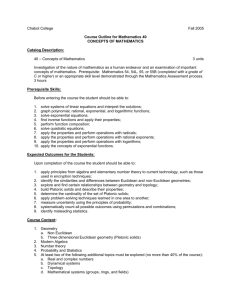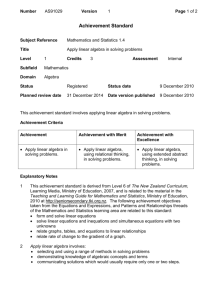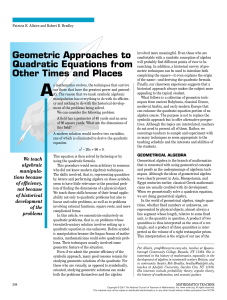Algebra_I-M4-A-Lesson_5-Teacher_Materials
advertisement

Lesson 5 COMMON CORE MATHEMATICS CURRICULUM M4 ALGEBRA I Lesson 5: The Zero Product Property Student Outcomes Students solve increasingly complex one-variable equations, some of which need algebraic manipulation, including factoring as a first step and using the zero product property. Lesson Notes In this lesson we discover ways to use the factoring skills honed in the last four lessons to solve equations involving quadratic expressions. We begin with an exploration of the zero product property and a discussion of how and why it is used. Students then use the property to solve basic one-variable equations, many of which are presented in the context of area (A-CED.A.1). Classwork Opening Exercise (3 minutes) Scaffolding: Opening Exercise Consider the equation true? . What values of , , , and would make the equation Any set of values where one of the four variables was equal to zero, and also values where two of the variable or three of the variables or even all four of the variables were equal to zero.. State or show the zero product property. Make connections between the example above and the given property. Zero Product Property If Lesson 5: Date: , then or The Zero Product Property 2/6/16 or If students struggle with the concept of the zero product property, ask them to try substituting numbers into the equation until they find one or more that make the equation true. Point out that in every case at least one factor must be . You can go back one step further by asking for a product of any two numbers that equals from several students in the class. Then ask what they notice about the numbers used in the products. Relate those numerical products to the equations in this example. 53 Lesson 5 COMMON CORE MATHEMATICS CURRICULUM M4 ALGEBRA I Exercises 1–4 (8 minutes) Exercises 1–4 Find values of and that satisfy each of the following equations. (There may be more than one correct answer.) 1. Either or must be zero but the other can be any number, including zero (i.e. both and zero at the same time). MIGHT both be equal to 2. There are an infinite number of correct combinations of and , but each choice of c will lead to only one choice for d and vice versa. For example, if , then must be , and if , then must be . 3. Since the product must be zero there are only two possible solution scenarios that will make the equation true, (and can be anything) or (and can be anything); specifically, one solution would be and . Why can we easily pinpoint a number that must be substituted for to make but not for a true statement ? Refer to the zero product property. Discuss that if the expression is set equal to zero, we know that at least one factor must be equal to zero, limiting the number of possible solutions. Therefore, it is more convenient to set an expression equal to zero when solving. 4. or . Either makes the product equal zero. (They COULD both be true, making the product but they do not HAVE to both be true. However, at least one MUST be true.) , Example 1 (17 minutes) Ask students to read the problem’s prompt in their materials and to take notes as you read the questions below aloud. They should work in pairs or small groups to find the answers. Example 1 For each of the related questions below use what you know about the zero product property to find the answers. a. The area of a rectangle can be represented by the expression, Lesson 5: Date: The Zero Product Property 2/6/16 . Write each dimension of this 54 Lesson 5 COMMON CORE MATHEMATICS CURRICULUM M4 ALGEBRA I rectangle as a binomial, and then write the area in terms of the product of the two binomials. The factors of are shorter side (width) and , so the dimensions of the rectangle will be on the on the longer (length). b. Can we draw and label a diagram that represents the rectangle’s area? The diagram below models the problem in a way that avoids negative areas. Let the students try using a diagram for this problem, but suggest it will not be easy to do so in a way that avoids negative areas. Try drawing the diagram shown or ask a student who did a particularly good job to display hers for the class to examine. Note: It is also very important to point out an area model represents the relationship between the areas and is not to be set as an actual size. In fact, every student in your class could draw a different scale diagram, with the length of looking like a different number of units in length and all could be a correct model. c. Suppose the rectangle’s area is square units? Can you find the dimensions in terms of ? (Use the following questions to guide students through solving this part of the problem.) What is the problem asking us to do? Start by asking students if they can find a number to substitute for that will make the statement true. Substituting numbers into the quadratic expression to find a way to equal Still, making a table of values and seeing if we can get close to might be a viable strategy. Remind students that they need to find both solutions. (Correct solution is should prove daunting. or .) Should we use the factors we already know for quadratic expression on the left of the equation? Here is what that would look like: . Is this easier to see the solutions? When looking at the factored form, students may find one of the correct answers right away since has only two factor pairs to check. Even so, students should see that it is harder to find the solution(s) when the product is given as than it is when we know the product is . Also, remind students that there are two correct solutions and one may be easier to find than the other. Lesson 5: Date: The Zero Product Property 2/6/16 55 Lesson 5 COMMON CORE MATHEMATICS CURRICULUM M4 ALGEBRA I Is there a way to set the equation equal to zero rather than to ? What is the benefit of setting an equation equal to zero? What strategies have we used previously when dealing with similar equations to solve for the variable? Yes, we can set the expression equal to any number. However, setting it equal to limits the number of possible correct answers, making our solutions easier to find. In some cases, it is more efficient to leave the number the expression equals alone. For instance, when the structure of the expression makes it possible to simply take the square root of each side of the equation (e.g., Read part (d). What do you need to do first? ). We need to subtract (expanded form): Now solve for from both sides of the equation and put the quadratic in standard form in the new form of the equation. d. Rewrite the equation so that it is equal to zero and solve. becomes , which leads to or . Once we have solved for , how do we make sense of those numerical values? What do those values mean in the context of this problem? Why does only one value of work in the context? A numerical solution only makes sense if it yields dimensions that are positive. If we try as a solution and substitute it into the original expressions for each side of the rectangle, we arrive at a dimensions of and . ; However, having negative lengths is not viable for the rectangle. When we try the other solution, , we arrive at dimensions of and . . Therefore, is the only solution that is useful in the context of the original problem. Discuss substituting values into the original factored form of the expression to check. e. What are the actual dimensions of the rectangle? The dimensions of the rectangle are by , so the dimensions would be ft. by ft. f. A smaller rectangle can fit inside the first rectangle, and it has an area that can be expressed by the equation . What are the dimensions of the smaller rectangle in terms of ? Factoring the quadratic expression we get Lesson 5: Date: The Zero Product Property 2/6/16 56 Lesson 5 COMMON CORE MATHEMATICS CURRICULUM M4 ALGEBRA I g. What value for would make the smaller rectangle have an area of that of the larger? is easier to solve if we subtract left side gives us . So, from each side to get: or . Factoring the . Discuss which answer is correct based on this context. Emphasize the importance of striking or crossing out the rejected solution. Exercises 5–8 (10 minutes) The following exercises might be modeled, guided, or independent based on the needs of your students. Exercises 5–8 Solve. Show your work: 5. or 6. or (This one has two things to remember: that all terms have a factor of , and that sometimes the solution is a fraction.) 7. Lesson 5: Date: The Zero Product Property 2/6/16 57 Lesson 5 COMMON CORE MATHEMATICS CURRICULUM M4 ALGEBRA I or (Note: There is only one solution; rather, both solutions are in this case.) 8. Two numbers for which the product is and the sum is : and . So we split the linear term: And group by pairs: Then factor: So , or Lesson 5: Date: The Zero Product Property 2/6/16 58 Lesson 5 COMMON CORE MATHEMATICS CURRICULUM M4 ALGEBRA I Closing (1 minute) The zero product property tells us that if a product equals zero then at least one factor must be zero. Thus, the product of zero and any monomial, polynomial, or constant is always equal to zero. Lesson Summary Zero Product Property If , then or or When solving for the variable in a quadratic equation, rewrite the equation as a factored quadratic set equal to zero. Using the zero product property, you know that if one factor is equal to zero, then the product of all factors is equal to zero. Going one step further, when you have set each binomial factor equal to zero and solved for the variable, all of the possible solutions for the equation have been found. Given the context, some solutions may not be viable, so be sure to determine if each possible solution is appropriate for the problem. Exit Ticket (6 minutes) Lesson 5: Date: The Zero Product Property 2/6/16 59 COMMON CORE MATHEMATICS CURRICULUM Lesson 5 M4 ALGEBRA I Name ___________________________________________________ Date____________________ Lesson 5: The Zero Product Property Exit Ticket 1. Factor completely: 2. Solve for : 3. In what ways are Problems 1 and 2 similar? In what ways are they different? Lesson 5: Date: The Zero Product Property 2/6/16 60 COMMON CORE MATHEMATICS CURRICULUM Lesson 5 M4 ALGEBRA I Exit Ticket Sample Solutions 1. Factor completely: 2. Solve for : , so 3. or In what ways are problems 1 and 2 similar? In what ways are they different? Both involve the same quadratic expression. The first is just an expression (no equal sign) so cannot be solved, but has two factors that are irreducible over the integers. The second is an equation in related to those factors. and has two solutions that are Problem Set Sample Solutions Solve the following equations. 1. or 2. or 3. Lesson 5: Date: The Zero Product Property 2/6/16 61 COMMON CORE MATHEMATICS CURRICULUM Lesson 5 M4 ALGEBRA I or 4. Lesson 5: Date: The Zero Product Property 2/6/16 62











